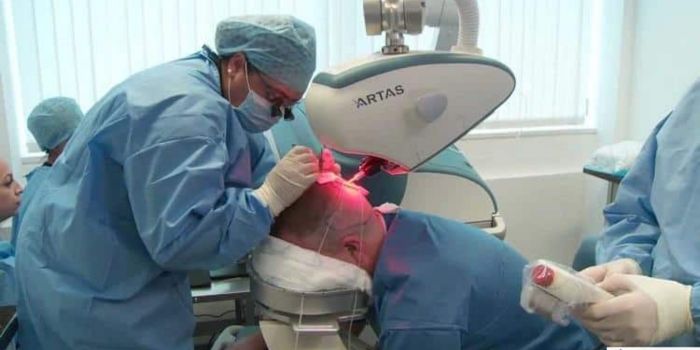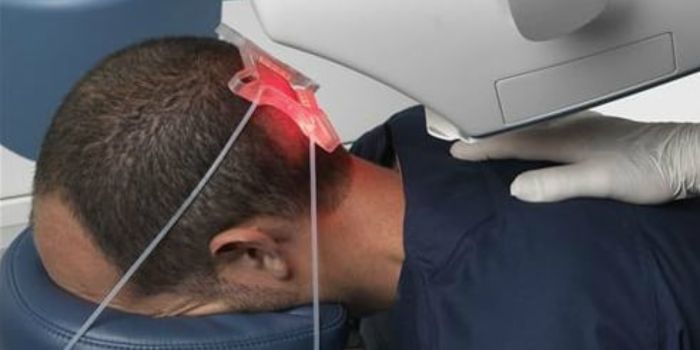aMillions of people over the world suffer from the frequent issue of hair loss. I have over seven years of experience as a hair restoration surgeon, and I have personally witnessed the negative effects that hair loss has on patients’ self-esteem. Thankfully, hair may regrow naturally and increase self-esteem because of contemporary hair transplant procedures like ARTAS Robotic Hair Transplant. Let’s read below about “Artas Hair Transplant: Innovative Technology for Hair Restoration”.
I’ll go over the advantages of the most recent ARTAS technology in this piece and why it’s a great choice for hair restoration.
Table of Contents
What is ARTAS Hair Transplant?
Automated Robotics Follicular Unit Extraction is referred to as ARTAS. This cutting-edge robotic tool assists doctors during hair transplant procedures. This method removes the need for human graft maintenance by enabling the robotic arm to collect hair follicular units under high-magnification imaging.
To precisely locate and remove high-quality grafts from the donor location, the ARTAS method is applied. Next, in line with the surgeon’s plan, the robotic arm builds microscopic recipient sites and inserts the grafts. This automated procedure minimizes human error while producing reliable outcomes.
I’m a hair restoration surgeon, and I’ve performed several successful surgeries using ARTAS technology. Because of the accuracy and precision of this technology, I am able to constantly give my patients excellent results.
Benefits of ARTAS Hair Transplant
The following benefits of hair transplantation using the ARTAS technique:
1. High Graft Survival Rate
With superior viability and over 95% graft survival rates, each transplant is expertly removed and inserted by the robotic arm of ARTAS. Manual extraction decreases survival and may harm the grafts.
2. Minimal Invasiveness
The donor area is stitch-free and left scar-free following ARTAS. The robotic punch’s tiny, spherical wounds heal rapidly and don’t leave many scars. The patient experiences reduced discomfort following the operation.
3. Quicker Recovery Time
Patients have less swelling and irritation when there are just linear scars instead of sutures. As a result, most patients recover more quickly and can resume their normal activities in two to four days.
4. Consistent Results
Graft extraction and implantation can be done consistently because to ARTAS’s robotic accuracy. Unlike less consistent manual approaches, this yields consistent, natural-looking outcomes.
5. Undetectable Transplanted Hair
ARTAS implants grafts with the proper density, angles, and distribution for a natural-looking outcome using imaging guidance. The hair transplant perfectly matches the natural hair.
6. No Human Handling of Grafts
Handling human grafts is a difficult task that is taken over by the robotic arm. Reduction in folliculcle destruction results in higher transplant quality.
7. Large Sessions Possible
Sessions with a maximum of 2500–3000 grafts in a single day are allowed by ARTAS. Only 700–1200 manual FUE grafts can be completed by respectable medical practitioners in a given day.
8. Minimal Technician Involvement
Large technical workers are no longer required thanks to the robotic technology. The OR has a reduced staffing demand.
I can personally attest to the superiority of ARTAS over manual FUE and antiquated robotic procedures as a licensed hair transplant surgeon. Excellent outcomes are obtained when cutting-edge technology and surgical expertise are combined.
ARTAS Hair Transplant Process
The three primary steps of an ARTAS hair transplant procedure are as follows:
1. Design Session
The surgeon considers the patient’s desired density, the availability of donors, and hair loss patterns. Next, the transplant is created with practical considerations in mind.
2. Graft Harvesting
The patient’s scalp is sedated prior to the ARTAS robotic arm carefully removing follicular unit grafts from the sides and back of the scalp during the transplant procedure. Optimal graft selection is ensured by image guiding.
3. Graft Implantation
The surgeon meticulously selects the recipient locations for each graft before inserting it with the robotic arm. The patient’s natural hair pattern, density, and angles are all replicated.
The degree of baldness and the desired fullness determine how many transplanted hairs are used. It may be sufficient to use 1500–2500 grafts for mild to moderate hair loss. Three to four thousand transplants may be required for patients with advanced baldness.
I go over everything in detail with each of my patients regarding what to anticipate from their ARTAS hair transplant process. Patients should have realistic expectations about the density that can be attained, even if the results seem natural.
My Experience with ARTAS Hair Transplant
I was among the first in India to execute more than 500 robotic hair transplant treatments. Here are a few of my experience’s high points:
- exceptional yields and graft quality; over 95% of grafts survive, according to ARTAS. Compared to human FUE, the robotics’ accuracy reduces the possibility of harm and transection.
- I can safely remove and transplant up to 3500 grafts in a single session using ARTAS. This makes it possible to significantly improve advanced baldness with a single surgical procedure.
- The speed at which my patients recover from ARTAS treatments and the natural-looking outcome have left them extremely satisfied. The benefits of modern robotics technology are substantial.
- To operate the ARTAS system, a surgeon must possess specialized training and surgical competence. Moreover, I can exploit the advantages of this technology as a skilled hair transplant surgeon to get exceptional outcomes.
- Further advancements in the hardware and software of ARTAS have further improved the system. Even more accuracy is provided by the most recent ARTAS iX system with dynamic image guidance.
After doing hundreds of surgeries, I’ve honed my skills to get the best results possible using ARTAS hair transplants. To achieve natural-looking results, considerable preparation, surgical skill, and a creative vision are required.
Who is the Ideal Candidate for ARTAS Hair Transplant?
The person listed below might gain the most from an ARTAS hair transplant:
- Norwood, a patient with mild to severe baldness, at or below the fourth-grade level
- Sufficient donor hair for the sides and back of the head Reasonable estimations for the degree of general
- health restored, the density reached, and the lack of problems preventing healing
- Additionally, Absence of intricate scars from prior scalp surgery
Moreover, younger individuals who have just started to lose hair typically have larger donor pools and better percentages of successful grafts. ARTAS is a proven hair restoration technique that benefits individuals of all ages and genders.
Patients with extensive Norwood Grade 7 hair loss might not be the ideal candidates, as more than 4000-5000 grafts are needed. In certain cases, ARTAS FUE in conjunction with scalp reductions may be advised.
I carefully evaluate each patient’s candidacy during the consultation, taking into account their expectations, medical history, the availability of donors, and the degree of their hair loss. I offer practical suggestions to optimize their transplant outcomes.
Why Choose an Experienced ARTAS Hair Transplant Surgeon?
Although ARTAS provides state-of-the-art technology, a successful outcome still depends on the surgeon’s ability and knowledge. Use the following guidance to determine which ARTAS hair transplant surgeon is ideal for you:
- Seek out a hair restoration surgeon with at least five years of expertise and board certification. ARTAS is a difficult system to use.
- Make sure the surgeon has completed 300–500 ARTAS procedures, at the absolute least. For the finest results, experience honed technical and artistic abilities.
- Examine the before and after photos to gauge the surgeon’s aesthetic sense and skill at producing realistic hairlines.
- Select a surgeon who stays up to date on ARTAS technology advancements by engaging in ongoing education.
- Select a facility that provides the highest degree of customisation possible (ARTAS FUE), which blends manual and robotic FUE.
I was the first in India to perform ARTAS hair transplants, thus I have the knowledge and expertise to provide results that look natural. I maintain up to date with the most recent developments in ARTAS technology by means of ongoing education and training.
Conclusion
At last, modern, less invasive hair replacement with amazing results and a short recovery time is provided by ARTAS. As a skilled hair transplant surgeon, I heartily advise eligible patients with mild to moderate baldness to consider ARTAS.
However, the ability of the surgeon plays a major role in establishing natural hairlines and prolonging the life of transplants. Make sure the hair transplant surgeon you select has both an artistic vision and verifiable ARTAS experience by doing your homework. I hope you like reading “Artas Hair Transplant: Innovative Technology for Hair Restoration”.

Kannaiah Thallapally is a seasoned hair restoration expert with a strong background in advanced hair transplant techniques. As an Associate Member of the International Society of Hair Restoration Surgeons (ISHRS), Kannaiah combines his extensive knowledge with a commitment to the latest industry practices. His expertise is showcased on hairstransplant.in, where he provides valuable insights into hair restoration solutions. Kannaiah is dedicated to helping individuals achieve their desired results and restore their confidence. Connect with him on Instagram for more updates and expert tips.
